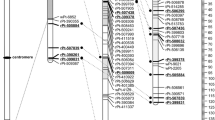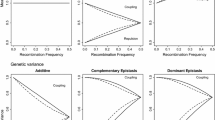Abstract
Marker assisted selection (MAS) and wheat doubled haploids (DH) are relatively new technologies, recently applied to wheat breeding programs. Simulations demonstrate that DHs increase the efficiency of MAS, and offer faster strategies for combining large numbers of genes with a minimum number of marker tests. When small numbers of marked loci (1-3) are selected simultaneously, selection of DH progeny is 5-6 times more efficient than selecting F4 derived families. Combining 4-8 marked loci, screening of F2 plants and using only those plants homozygous or segregating for all of the marked loci as parents for DH production (10-31% of F2 plants) is 3-10 times as efficient as using F1 plants. A number of protocols have been proposed involving sib-matings and selection to fix some genes, with further selection in the second generation to improve the proportion of useful DH lines. In one scheme (recombinant F2 selection) all F2 plants, either homozygous or heterozygous for the marked alleles, are intercrossed at random and the recurrent F1 plants still having these alleles are used for DH production. An alternative strategy (recurrent DH selection) is to select from an initial DH population and intercross those lines having most favourable marked loci with a second cycle of DHs to fix all favourable marked loci. Combining more than 12 marked gene loci does not seem feasible, due to the very large numbers of F2s (>2000) required. This has implications when using MAS for quantitative trait loci, where many minor gene loci would have to be combined. Direct selection for some multi-genic quantitative traits amongst the DH lines may be more efficient than using MAS where recurrent selection is used. At the Cereal Research Centre, the practical problems of using these protocols as part of the spring wheat breeding program are being evaluated.
Similar content being viewed by others
References
Aung, T., N.K. Howes, R.I.H. McKenzie & T.F. Townley-Smith, 1995. Application of the maize pollen method for wheat double haploid (DH) generation in western Canadian spring wheat breeding programs. Annual Wheat Newsletter 41: 70.
Baker, R.J., 1968. Extent of intermating in self-pollinated species necessary to counteract the effects of genetic drift. Crop Sci 8: 547–550.
Clarke, J.M., N.K. Howes, J.G. McLeod & R.M. DePauw, 1993. Selection for gluten strength in three durum wheat crosses. Crop Sci 33: 956–958.
Demeke, T., A. Laroche & D.A. Gaudet, 1996. A DNA marker for the Bt-10 common bunt resistance gene in wheat. Genome 39: 51–55.
Howes, N.K., M.I.P. Kovacs, D. Leisle, M.R. Dawood & W. Bushuk, 1989. Screening of durum wheats for pasta-making quality with monoclonal antibodies for gliadin 45. Genome 32: 1096–1099.
Jansen, R.C, 1992. On the selection for specific genes in doubled haploids. Heredity 69: 92–95.
Kovacs, M.I.P., N.K. Howes, D. Leisle & J. Zawistowski, 1995. Effect of two different low molecular weight glutenin subunits on durum wheat pasta quality parameters. Cereal Chem 72: 85–87.
Laurie, D.A. & M.D. Bennett, 1988. The production of haploid wheat plants from wheat x maize crosses. Theor Appl Genet 76: 393–397.
Lukow, O.M. & T.F. Townley-Smith, 1995. Association of extrastrong dough-mixing properties with HMW and LMW glutenin subunits. Amer Assoc Cereal Chem Annual Meeting, San Antonio, TX. Abstract No. 170. Cereal Foods World 40: 667.
Patel, J.D., E. Reinbergs & S.O. Fejer, 1985. Recurrent selection in doubled haploid populations of barley (Hordeum vulgare L.) Can J Genet Cytol 27: 172–177.
Penner, G.A., F. Townley-Smith, B. Legge & N. Howes, 1995a. The application of marker-assisted selection to cereal breeding. International Triticeae Mapping Initiative Meeting, 1995. Norwich, UK.
Penner, G.A., J. Clarke, L.J. Bezte & D. Leisle, 1995b. Identification of RAPD markers linked to a gene governing cadmium uptake in durum wheat. Genome 38: 543–547.
Penner, G.A., S.J. Lee, L.J. Bezte & E. Ugali, 1996. Rapid RAPD screening of plant DNA using dot blot hybridization. Molecular Breeding 2: 7–10.
Procunier, J.D. & M. Wolf, 1995. Multiplex touchdown PCR for the simultaneous identification of leaf rust resistance genes Lr29 and Lr25. Annual Wheat Newsletter 41: 71.
Procunier, J.D., T.F. Townley-Smith, S. Fox, S. Prashar, M. Gray, W.K. Kim, E. Czarnecki & P.L. Dyck, 1995. PCR-based RAPD/DGGE markers linked to leaf rust resistance genes Lr29 and Lr25 in wheat (Triticum aestivum L.). J Genet and Breed 49: 87–92.
Procunier, J.D., R.E. Knox, A.M. Bernier, M.A. Gray & N.K. Howes, 1997. DNA markers linked to a T10 loose smut resistance gene in wheat (Triticum aestivum L.). Genome 40: 176–179.
Author information
Authors and Affiliations
Rights and permissions
About this article
Cite this article
Howes, N., Woods, S. & Townley-Smith, T. Simulations and practical problems of applying multiple marker assisted selection and doubled haploids to wheat breeding programs. Euphytica 100, 225–230 (1998). https://doi.org/10.1023/A:1018308307403
Issue Date:
DOI: https://doi.org/10.1023/A:1018308307403




